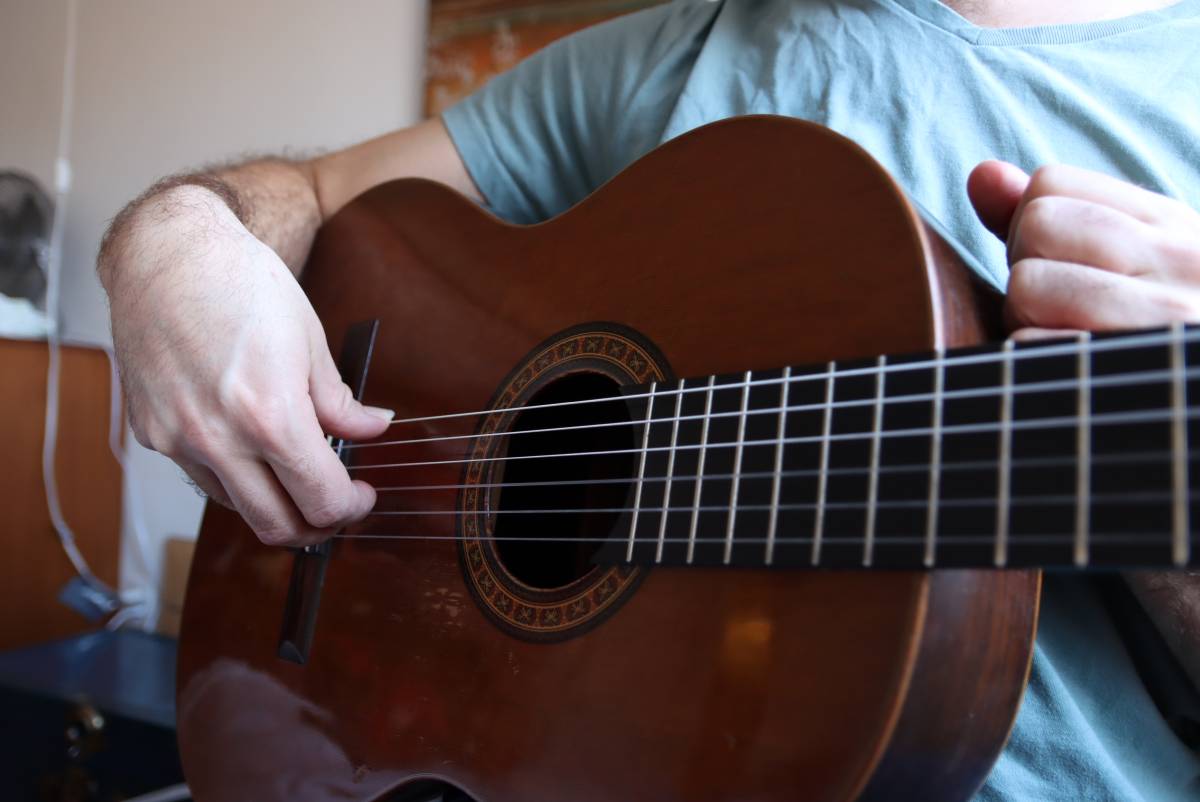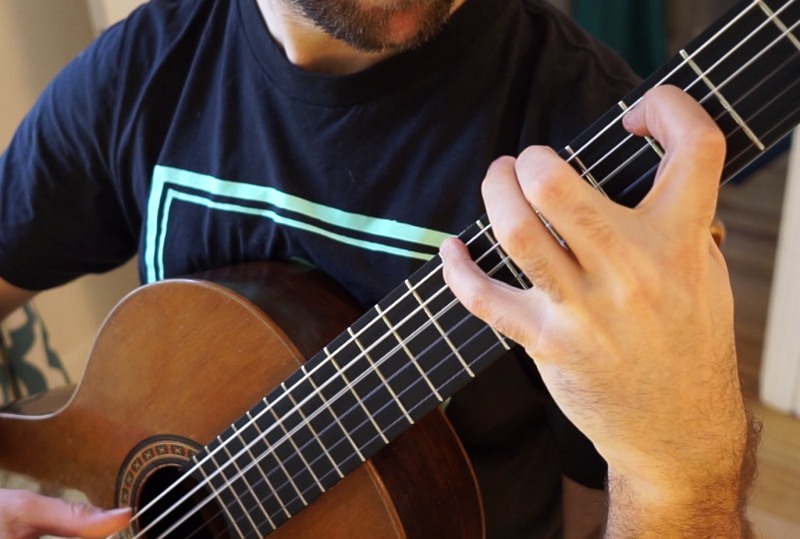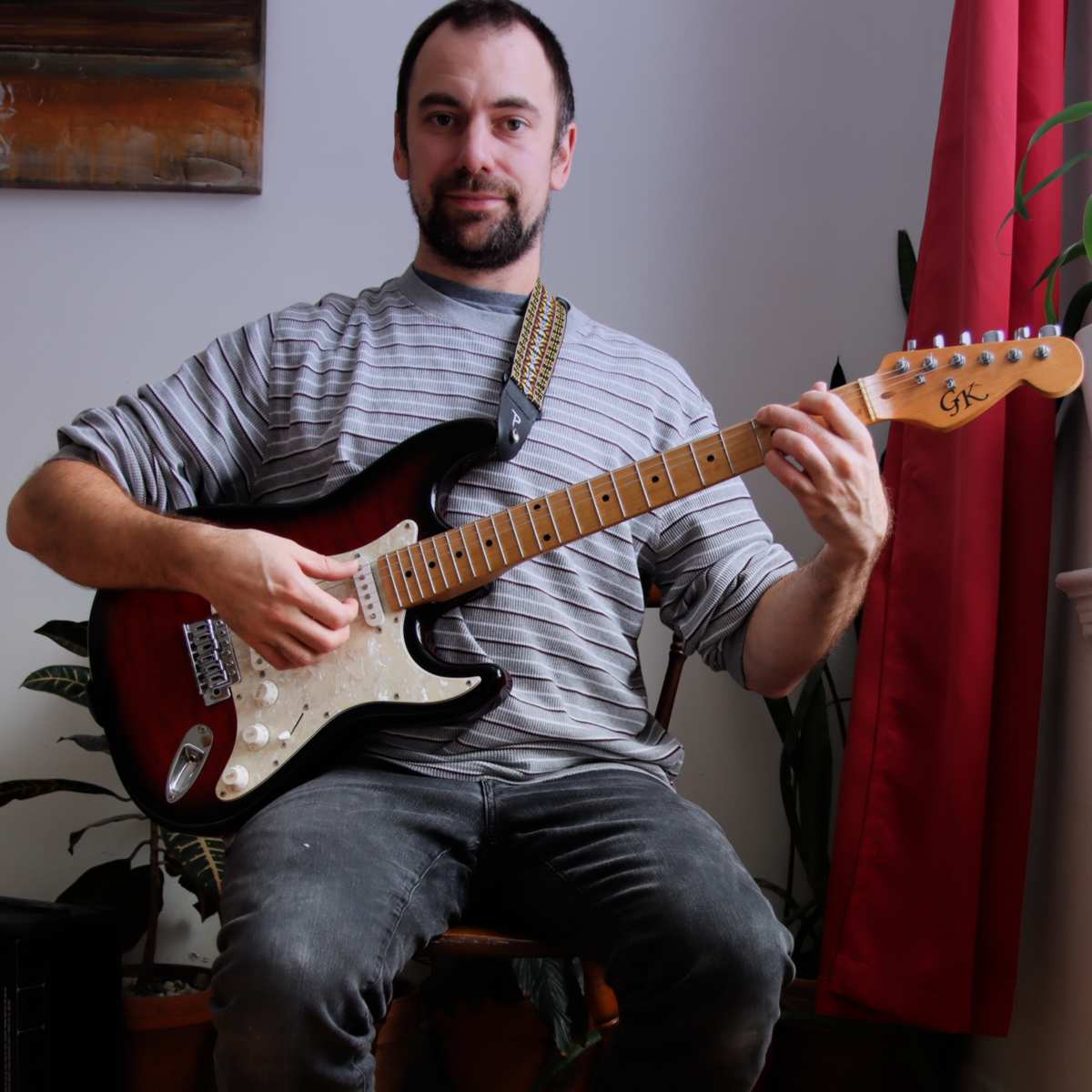Here's what you need to know in order to play guitar without peeping constantly at both hands.
When I was in Grade 3, we had to take a touch typing class, in order to learn how to type without looking at the keyboard.
The teacher showed us how to type each letter one finger at a time, using the home row as a base.
Now I can type without looking at the keyboard and it certainly helps when writing posts like this one.
And did you know that the same skills that go into touch typing can also help you play guitar without looking?
I'll show you how to play guitar without looking at your hands, so you can become a faster and more efficient guitar player.
How To Play Guitar Without Looking At Your Hands
Playing guitar without looking at your hands relies on a concept called proprioception. This is the ability to sense the position and movement of your body parts without looking at them.
Here's a demonstration. Start by trying to touch your left elbow with your right index finger without looking at either of your arms. Simple, no?
Playing guitar without looking at your hands simply requires that you develop proprioception with your guitar, being able to sense where your fingers are located using your internal visualization.
Of course, the guitar neck is huge and it can be difficult to accurately place the finger on a precise string or fret without looking. Therefore, it's acceptable and even necessary to play guitar while looking at the fretting hand.
Instead, you should develop the ability to play the guitar without looking at the plucking hand.
How To Pluck The Strings Without Looking At Your Hand
Did you know that our brains process tactile information better than visual? Yup, science says so! So, by feeling for the string thickness with your thumb, you're actually training your brain to recognize the strings more accurately.
To begin mastering this technique, start by exploring the sensations of your fingers on the strings. Pay close attention to the different thicknesses of the strings.
Plucking The Sixth String
The sixth string is the thickest string and it's the easiest one to pluck without looking.
One key benefit of the sixth string on a guitar is that there are no other strings above it. This unique positioning allows you to confidently pluck the bottom string without needing to look at it.

With no risk of accidentally hitting a lower-pitched string, you can play the sixth string with precision and ease.
The Fifth String
Now, the fifth string only has one other string above it. Try to feel the difference in thickness between the sixth and fifth strings by touching each string with your fingertip.

When you're trying to identify the fifth string, you can also use your thumb to feel for the sixth string, which should be right next to it. This way, you'll know you've got the right string when you feel its neighbour.
Fourth string
Next, try to judge the difference between the fifth and fourth strings only by touching them with your thumb.
The fifth and fourth strings on an acoustic guitar are like two different textures on a fabric. The fifth string is like a soft, plush velvet - smooth and luxurious under your thumb. The fourth string, on the other hand, is like a rougher, nubby corduroy - slightly more stringy and less flexible.
The Treble Strings
The third, second and first strings are not plucked with the thumb. The third and second strings on the acoustic are distinctly different.
The third string is wound and the second string is made of plain steel.
Since you are plucking these strings with your fingers, you should be able to distinctly feel the difference in texture between these two string types.
How To Practice Plucking Without Looking
Start by placing your hand in a neutral position on the guitar strings. Now, with the flesh of your fingers, try to guess which string each hand is touching. Then pluck each string one at a time, starting with the thumb, index, middle and ring.
Did you guess the strings correctly? Practice this guessing exercise with arpeggios - holding a chord and playing more complex right hand fingerpicking patterns. Keep the fretting hand super simple and play the patterns without looking at your hands.
In this way, you will develop right hand independence and you will be able to concentrate on your fretting hand, which is normally tasked with more acrobatics.

The reason behind only looking at the left hand when you play fingerstyle guitar is that it must cover a much larger playing distance than the right hand.
So, there is more chance for error if you look at the plucking hand when you are playing a fingerstyle guitar song instead of the fretting hand.
Also, if you are constantly looking at both hands, your playing will be hesitant and not very smooth. As you are concentrating on one hand, try to imagine the location and placement of the other hand on the guitar.
How To Play Songs Without Looking
Now that you have progressed on to plucking the strings with your fingers, it's time to learn how to play more complex fingerstyle without looking.
To figure out where to place your right hand on the guitar, try using this visualization technique. Say you want to pluck the second string but you need to fret a complicated chord, so you are looking at your fretting hand.
As you stare at your fingers doing a complicated chord, imagine the string extending out and away from your hand, out of sight, all the way to where your plucking hand is. Can you sense where the string ends up?
Here, I've fretted the G chord and I've placed my fingers on the sixth, third, second and first strings without looking.

Now, go ahead and use your other hand to pluck the string and see how accurate you are.
Now, try the same exercise with the third string. Imagine it stretching from the section that you can see on the fretboard all the way to the bridge. Now place your finger on the third string. But wait!
Remember what we said before about the string having a different texture!
Double-check, then pluck it with your finger and check how close you were to the correct spot.
How To Play Fast Without Looking
Now, I know what you're thinking. "But what about those lightning-fast plucking patterns?"
Here's the thing.
Once your plucking hand is in the zone, your fretting hand will catch up like a caffeine-fueled cheetah. It's all about simplifying the plucking hand, keeping it steady and neutral, like I explain in the course Play Fingerstyle Guitar Now!
Most complex fingerstyle songs, such as music by Sungha Jung, will require you to place almost your full attention on the fretting hand. If you're bobbing your head between both hands, it's like trying to juggle while riding a unicycle while trying to keep your eyes on the pedals and the balls.
Keeping a steady right hand position and avoid changing the position of your plucking hand too much will let you keep your eyes on the fretting hand.
Also, being able to return to a neutral hand position as quickly and as naturally as possible is a huge asset. In Play Fingerstyle Guitar Now! you will learn exactly what a neutral hand position should feel and look like.



